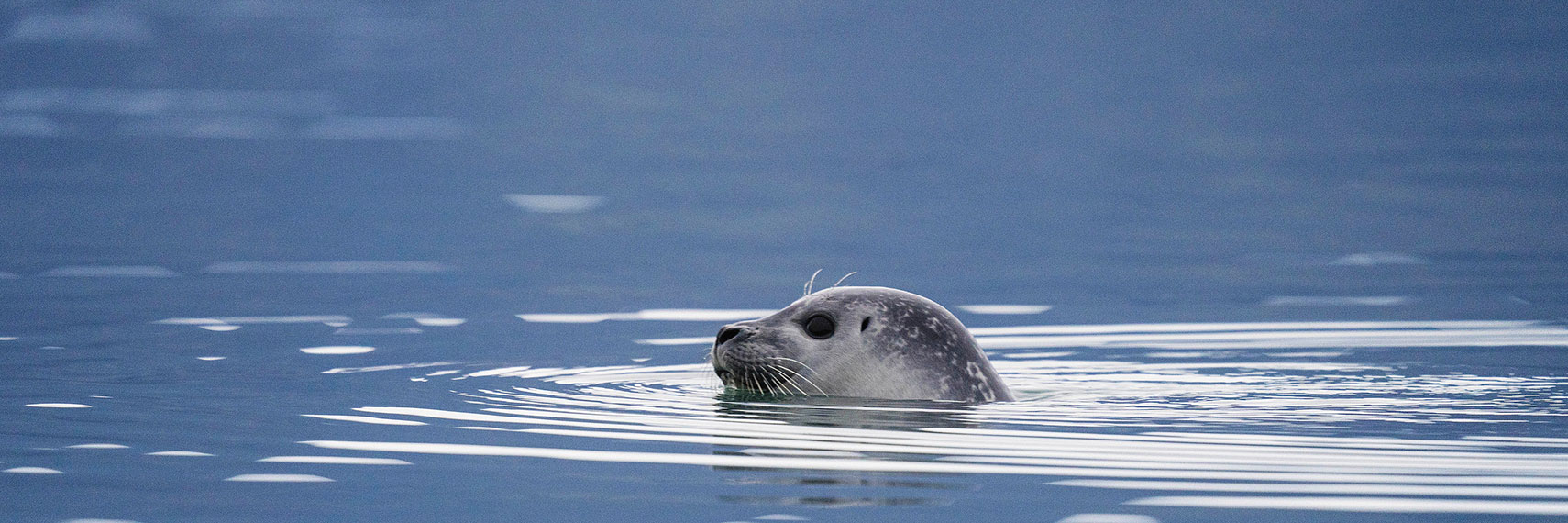Overview
In 2004, the Native Village of Kotzebue received a grant from the U.S. Fish and Wildlife Service (FWS) to undertake a project to live capture young of the year bearded seals and fit them with satellite tags that will record movement, diving, and hauling out behavior. The project was funded from the new federal FWS program called Tribal Wildlife Grants. The official name of the project is “Habitat use, seasonal movements and stock structure of bearded seals in Kotzebue Sound, Alaska” and the principal investigators (PI’s) are Alex Whiting, Kathy Frost, Lloyd Lowry, Willie Goodwin, and Roswell Schaeffer. The project has been designed as a cooperative effort between biologists and local Kotzebue-area hunters and will combine local knowledge about the distribution and habits of bearded seals with the knowledge of biologists about how to catch and tag seals and to analyze data recorded by the tags.
This project responds to concerns of coastal hunters throughout northern Alaska that there is currently no ongoing directed research or management program for bearded seals an important marine mammal resource throughout western and northern Alaska. Bearded seals were identified as the highest priority for research at a July 2003 meeting of Alaska Native resource managers, scientists, and state and federal agencies to discuss ice seal conservation and management. This project will provide information about habitat use and stock identification for the bearded seals found in Kotzebue Sound.
The demand for bearded seal meat and other products has not diminished as coastal lifestyles have changed. Despite their importance to coastal residents, there has been no research conducted on bearded seals in Alaska since the mid-1970s and there is no recent information on movements, abundance, population status, or trends. Because bearded seals are such an important subsistence species and are hunted in so many communities throughout Alaska, it is essential to learn about their distribution, movements, stock identity, population status, and natural history.
Bearded seals are the most important marine mammal subsistence species for hunters in Kotzebue Sound and they are harvested extensively in spring on the pack ice and fall in open water and as freeze-up approaches. There is currently no information about stock identity, and whether Kotzebue Sound bearded seals belong to the same stock as those hunted elsewhere in Alaska (Bering, Chukchi, and Beaufort seas), as well as in Russia.
A variety of industrial activities occur in regions where bearded seals are found, for example, Red Dog Mine shipping and port site docking north of Kotzebue, and Bering Sea crab fisheries in what is likely their wintering areas. Information provided by satellite tags will help to identify important bearded seal habitats and facilitate the development of appropriate guidelines to minimize the impacts of human activities on bearded seals.
Prior to this project, bearded seals had never been tagged in Alaska. Tag data obtained by this study will be used to gather information about seasonal movements, habitat use, and diving behavior of bearded seals. This information can then be used to help develop policies and guidelines for human activities that occur in bearded seal habitats. Information on the hauling out/diving behavior of these seals will be useful for designing methods to census these seals and develop population estimates that can be used in future management strategies.
Objectives
- Satellite tag 12 or more bearded seals in order to provide information about seasonal movements/locations and associations with habitat features such as bathymetry and sea ice and to determine dive depths and durations, seasonal and regional differences in diving behavior, and hauling out behavior to be used in designing better population assessment techniques and identify important bearded seal habitat that should be protected;
- Obtain samples for use in identifying the stock using Kotzebue Sound;
- Produce a report of findings to assist with efforts to create ice seal management plans for Alaska stocks;
- Share the results of this study with local hunters and residents through a Science Workshop;
- Develop a cooperative approach between the Tribe and resource managers in planning and conducting research on a marine mammals, while building the capacity of the Tribe and its members to actively participate in the research of marine mammals on which they depend for their cultural and nutritional needs.
Timeline
YEAR 1
- Summer 2004 Plan logistics, order tags
- Fall 2004 Field work to tag seals
- Fall 2004 Collect genetics samples from harvested seals
- Fall 2004-Spring 2005 Download and process location data from tagged seals, make weekly maps for distribution
- Winter 2004/2005 Begin analysis of genetics samples
YEAR 2
- Winter 2005 Plan logistics, order tags
- Summer/Fall 2005 Field work to tag seals
- June – October 2005 Collect samples from harvested seals
- Spring 2005-spring 2006 Download and process location data from tagged seals, make weekly maps for distribution
- Winter 2005/2006 Analysis of genetics samples
YEAR 3
- Summer 2006 Plan logistics for field work
- Fall 2006 Field work to tag seals
- Ongoing Download and process location data, make weekly maps for distribution
YEAR 4
- Ongoing Map location data
- Ongoing Analyze location and dive data
- Fall 2007 Community Newsletter Project Report
- December 2007 Final Report
Geographic Location
The area of investigation for this study is in northwest Alaska, specifically northern Kotzebue Sound and Hotham Inlet ( Kobuk Lake). The netting areas included Sisualik and York’s Bay (see map). Nets were from mid-September until mid-October when freeze-up made netting no longer possible.




